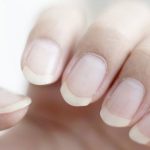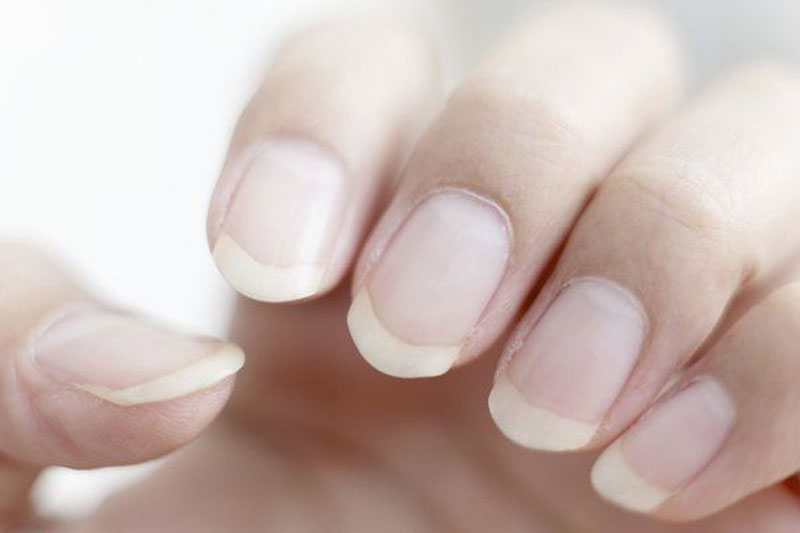 A hard growth, made of keratin, which forms on the top surface at the end of each finger and toe.
A hard growth, made of keratin, which forms on the top surface at the end of each finger and toe.
Flattened, horny structure, made of keratin from epidermis, at the end of each finger and toe. Each nail is composed of a root, body, and free edge. The root fits into a groove in the skin and is closely molded to the skin of the finger or toe with the nail fold overlying the root. The body of the nail lies over the nail bed; the white crescent shaped structure at the base of the body is the lunula. Nails grow longer as cells in the stratum germinativum of the root proliferate. Also called unguis.
The hard, protective shield of protein on the top of each finger and toe tip. The protein of which the nail is composed is called keratin, the same substance that makes up hair and the outer portion of the skin. Like hair, the visible portion of the nail is dead, but it grows from a living nail root that extends back into a groove in the skin. The whitish, crescent-shaped area at the base of the nail is called the lunula. The cuticle, a piece of skin that lies just in front of the nail root, helps protect the new, emerging keratin cells. The nail protects the end of the finger or toe, and it also registers certain types of pressure involved in the sense of touch.
A horny structure, composed of keratin, formed from the epidermis on the dorsal surface of each finger and toe. The exposed part of the nail is the body, behind which is the root. The whitish crescent-shaped area at the base of the body is called the lunula. Growth of the nail occurs at the end of the nail root by division of the germinative layer of the underlying epidermis (which forms part of the matrix). The growing nail slides forward over the nail bed. The fold of skin that lies above the root is the nail fold; folds of skin on either side of the nail are the nail walls. The epidermis of the nail fold that lies next to the nail root is called the eponychium (forming the cuticle at the base of the nail).
A rod made of metal, bone, or solid material used to attach the ends or pieces of broken bones.
A rigid, curved plate made of keratin – a durable protein also prevalent in skin and hair – forms on each finger and toe. Nails originate from a region termed the nail bed. Positioned at the nail’s base, a half-moon contour known as the lunula is overlapped by a skin fold called the cuticle. The encircling skin is referred to as the nail fold. Approximately six months are needed for a fingernail to develop from its foundation to its tip, although growth rates can vary seasonally. In comparison, toenails take twice as long to complete this growth cycle.
Nails can be vulnerable to harm from injuries, often stemming from crushing or pressure on the nail. Additionally, bacterial or fungal infections, notably tinea and candidiasis (thrush), can cause nail damage. In cases of paronychia, it’s the nail folds that become infected. Occasionally, nails may also develop an abnormal thickening and curvature, a condition termed onychogryphosis. This primarily impacts the big toes of elderly individuals.
Nails can also be impacted by various skin diseases. Illustrations of the influence of skin conditions on nails involve the occurrence of pitting in alopecia areata, the combination of pitting and detachment of the nail from its bed in psoriasis, and the development of scars on the nails due to lichen planus. Specific nail irregularities can signify more widespread ailments. Brittle, ridged, and concave nails serve as indicators of iron-deficiency anemia, while fibrous growths on the nail can point to tuberous sclerosis. In certain bleeding disorders, splinter-like black marks emerge beneath the nails, indicating bleeding within the nail bed.
Irregularities in nail color can also serve as indicators of underlying conditions. A greenish hue might arise from a bacterial infection beneath the nail, while blue nails can be suggestive of respiratory or heart issues. Yellow nails that are rigid and curved can manifest in the lung condition bronchiectasis and lymphoedema (the buildup of lymph in tissues). Nails may also undergo discoloration due to smoking (attributable to nicotine) and the application of nail polish.
Addressing nail disorders can prove challenging. Creams and lotions often struggle to deeply penetrate, and oral medications might require several months to yield noticeable results.
The hard covering at the tip of each finger and toe.
